The GatorPrime system has been constructed based on biolayer interferometry (BLI) technology, allowing real-time measurements. It assists in analyzing biological molecules at various stages of therapeutic development.
The Gator instrument helps quantify the interference pattern caused by variations in the amount of protein limited to the probe tips. This is beneficial for studying protein–protein interactions: binding constant determination, off-rate screening, affinity maturation, yes/no binding to target antigens, and epitope binning.

Image Credit: Gator Bio, Inc.

Image Credit: Gator Bio, Inc.
The GatorPrime system
The GatorPrime system consists of instrumentation, software, and a selection of probes. The combined software integrates acquisition and analysis to allow setup from start to finish. Several ELISA assays, such as antibody titer determination and isotyping, could be implemented easily on the GatorPrime system.
Table 1. Source: Gator Bio, Inc.
| Gator probe |
Function |
Application |
Dynamic range |
Regeneration |
| Protein A |
Binds IgG’s of various species including human and mouse |
Q/K/QKR |
0.02 – 2000 μg/mL |
Yes |
| Protein G |
Binds IgG’s of various species including human and rat |
Q/K/QKR |
0.02 – 2000 μg/mL |
Yes |
| Protein L |
Binds IgG’s of various species through the kappa light chain |
Q/K/QKR |
0.1 – 2000 μg/mL |
Yes |
| Human Fc |
Immobilize human Fc-fusion protein or human IgG for quantitative or kinetic analysis |
Q/K/EP |
0.02 – 300 μg/mL |
Yes |
| Mouse Fc |
Immobilize mouse Fc-fusion protein or mouse IgG for quantitative or kinetic analysis |
Q/K/EP |
0.02 – 300 μg/mL |
Yes |
| Anti - FAB |
Binds F(ab), F(ab’)2, Fc receptor, and full length Human IgG |
Q/K/QKR/EP |
0.3 – 3000 μg/mL |
Yes |
| Anti – His |
Binds His-tagged proteins |
Q/K/QKR/EP |
Protein-dependent |
Yes |
| Streptavidin (SA) |
Binds biotinylated and Avi-tagged biomolecules |
Indirect Q/K/EP |
Protein-dependent |
No |
| Small Molecule, Antibody, and Protein (SMAP) |
Binds biotinylated and Avi-tagged biomolecules and subsequent binding of small molecules and protein |
Indirect Q/K |
>150 Da |
No |
| APS (Aminopropylsilane) |
Binds hydrophobic proteins |
Q |
Protein-dependent |
No |
| Amine-Reactive |
Covalently attach amine group of proteins using EDC/NHS |
Indirect Q/K/EP |
Protein-dependent |
No |
| Custom-Made |
Custom made biosensors for your specific applications (Ex: SARS-CoV-2 R&D biosensors for COVID research) |
Varies |
Varies |
Varies |
Epitope binning with GatorPrime system
When an antibody attaches to an antigen, it is not binding to the complete protein sequence. Rather, the antibody attaches to a segment of the antigen around five or six amino acids in length.
As such, a normal protein contains several epitopes that antibodies recognize and bind. As far as epitope binning is concerned, antibodies are tested in a pairwise combinatorial way, and those that struggle for the same binding region of the antigen are grouped collectively into bins.
An epitope bin is a relative concept that depends on the epitopes represented inside the panel of mAbs being tested.
The GatorPrime system tracks real-time binding and gives a clear idea of if a specific antigen–antibody pair is in a similar epitope bin based on variations in the signal or nanometer shift.
For epitope binning, various Gator Bio probes (Mouse Fc, Human Fc, Anti-His, etc) are available. The experiment can be set up to run premix, in-tandem, and classical sandwich formats. The materials and probes could be used again.
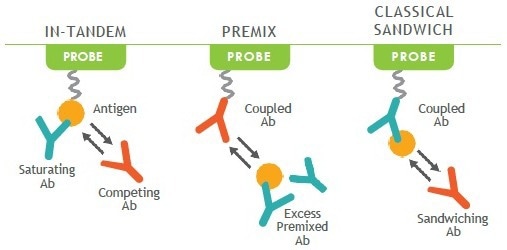
Image Credit: Gator Bio, Inc.
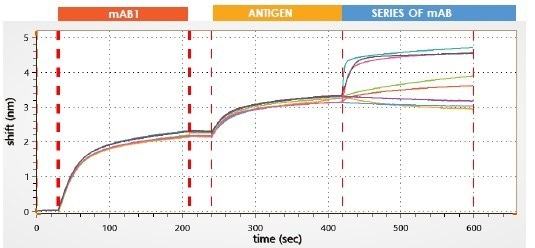
Epitope binning binding curve using in-tandem assay. Image Credit: Gator Bio, Inc.
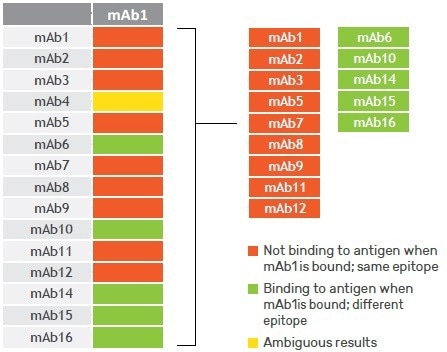
Epitope binning against supernatant. Image Credit: Gator Bio, Inc.
Antibody titer using Gator Bio Protein A biosensors
High-sensitivity Gator Bio Protein A biosensors enable the efficient and particular capture of any Fc-tagged protein that binds to protein A. The dynamic range for Gator Bio Protein A biosensors ranges from 25 ng/mL to 2 mg/mL in most commercially available media. It enables the analysis of an extensive range of hybridoma supernatants with one single setup.
Gator Bio Protein A biosensors could be regenerated over 20 times with easy regeneration conditions, and the same biosensors can be utilized over several days.
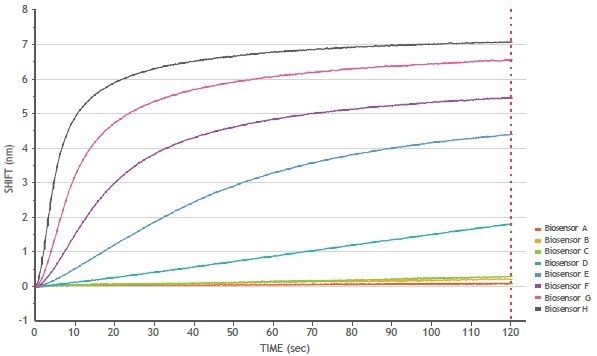
Standard curve for human IgG binding to GatorPrime Protein A biosensors. Image Credit: Gator Bio, Inc.
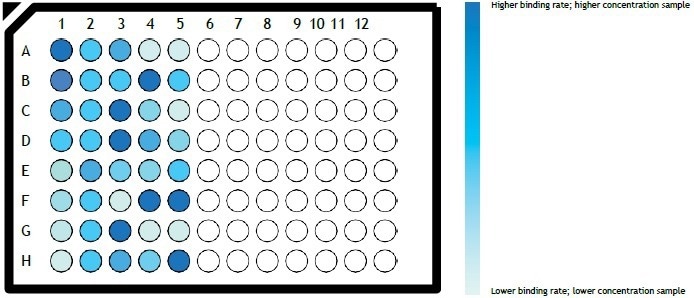
Heat map generated by GatorPrime software for human IgG concentration analysis using Gator Bio Protein A biosensors. Image Credit: Gator Bio, Inc.
Kinetic characterization using the GatorPrime system
The Gator system could be used to identify the kinetics of a drug molecule attaching to its target. The system allows rapid measurements of the dissociation rate (koff), association rate (kon), and equilibrium dissociation constant (KD) of antigen–antibody interactions with or without the usage of labeled reagents.
It is possible to use the Gator system for primary kinetic screening of antibody libraries in various crude media to identify the off-rate ranking as well as complete binding characterization of a purified antigen–antibody binding pair.
An extensive range of probes is available for the kinetic characterization of biological samples. Generally, Gator Bio biosensors are known to be highly adaptable and simply regenerable (excluding the SA biosensors) and could be utilized multiple times. This capability enables the user to establish several real-time binding assays with blank sensors and proper controls to get high-quality binding data.

Kinetic analysis of a purified antigen-antibody pair using Gator Bio Streptavidin biosensors. Image Credit: Gator Bio, Inc.
Highlights
- Eight various binding reactions can be performed concurrently
- Simple to tailor assay and fine-tune concentration ranges of analyte to get precise binding constants
- The binding constant can be identified within 20 minutes
- Extensive range of biosensor choices to quantify binding kinetics
Antibody isotyping and subtyping with GatorPrime system
Immunoglobulins, which are antibodies, might be classified into five major classes: IgA, IgD, IgG, IgE, and IgM. Various species might have particular subclasses or isotypes of antibodies within such five major classes.
Such subclasses tend to vary in the disulfide bonds connecting the two heavy chains of the antibody present in the constant region. For instance, among IgG in mice, there are IgG1, IgG2a, IgG2b, and IgG3. A main Gator Bio application is determining isotypes (IgG1, IgG2a, etc.) with Gator Bio Human Fc (HFC) and Mouse Fc (MFC) biosensors.
With the availability of Gator software, it is possible for users to easily and definitively determine the existence of antibody subtypes in crude samples, such as hybridoma supernatants.
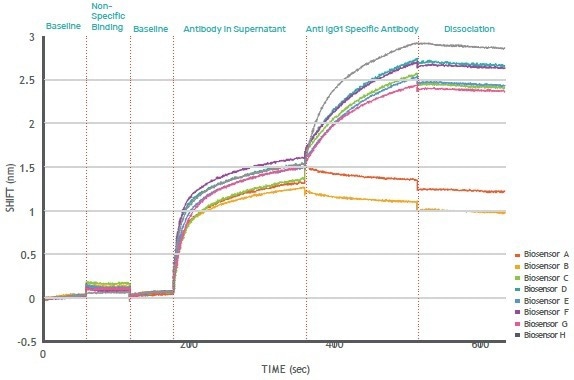
Hybridoma supernatant isotyping using Gator Mouse Fc biosensors. Image Credit Gator Bio, Inc.
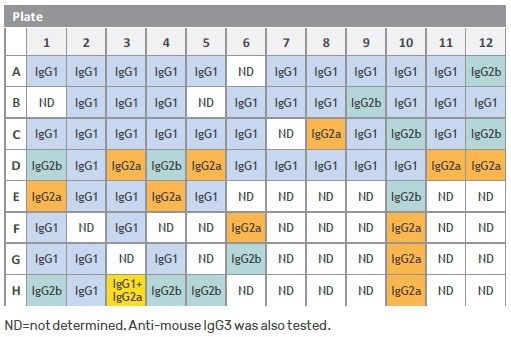
96-well plate with unknown isotypes of mouse IgG hybridoma supernatant characterized using Gator Mouse Fc biosensors. Image Credit: Gator Bio, Inc.
Highlights
- Determination of antibody isotypes can be done even in crude samples
- High sensitivity is provided
- Visual real-time binding outcomes
- Regenerable biosensors to save time and assay or cost
General
Table 2. Source: Gator Bio, Inc.
| GENERAL |
| Detection |
Biolayer interferometry |
| Number of channels |
8 |
| Data collection rate |
2 Hz, 5 Hz, 10 Hz |
| Orbital flow |
0 – 1,500 rpm |
| Instrument |
460 mm x 670 mm x 320 mm (H x W x D)
30 kg |
| Electrical |
110V – 220V 5A |
| Power |
200 W |
Software
- Combined data acquisition and analysis
- Epitope binning setup and analysis
- QKR—quantitation, kinetics, and regeneration in one run
- Operating system: Windows 10 Professional 64-bit
- Data analysis templates available for multiple binding models
- Smart search and a preview of outcomes
- Enables initiation of the next assay while the present one is in progress
- Real-time display of quantitative outcomes and heat map
Analysis
Table 3. Source: Gator Bio, Inc.
| ANALYSIS |
| Sample types |
Proteins, antibodies, peptides, DNA, RNA, liposomes, cells, viruses, etc. |
| Work flow |
- 2 x 96-well plates, in tilted or flat position
- Up to 8 samples in parallel, up to 96 samples per 96-well plate
|
| Types of analysis |
- Yes or no binding
- Relative and absolute concentration
- Kinetics and affinity
|
Quantitation
Table 4. Source: Gator Bio, Inc.
| QUANTITATION |
| Analysis time |
- IgG concentration in 30 seconds for 8 samples
- <10 minutes for 96 samples
|
| Linear range for Gator Protein A biosensor |
0.025 – 2,000 μg/mL |
Kinectics
Table 5. Source: Gator Bio, Inc.
| KINETICS |
| Analysis time |
Real-time kinetic binding from 1 minute to 4 hours |
| Association rate kon |
101 – 106 M-1 /s |
| Dissociation rate koff |
10-6 – 10-11 /s |
| Affinity constant KD |
10 pM – 1 mM |
| Binding curve baseline noise |
<3 pm (RMS) |
| Binding curve baseline drift |
<40 pm/hour (RMS) |